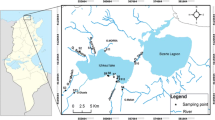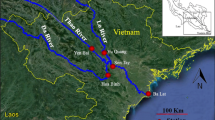Abstract
River toxic metal (TM) pollution is a serious challenge of present-day Iran, given that the majority of national developments are situated close to rivers. In this research, we measured and compared physicochemical quality properties, algae chlorophyll, carotenoid, and allophycocyanin contents, bioaccumulation factor (BAF), sediment quality indices, and the concentrations of Cd, As, and Pb in both sediment and algae samples across four seasons and at six reference stations along the Zayandeh-Rood River in Central Iran. The most abundant species were Spirogyra abbreviata, Spirogyra adnata, Characium acuminatum, and Navicula sp. The mean concentrations of TMs (mg/kg) were as follows: Pb(21.07) > As(5.46) > Cd(0.98) in sediment and Pb(25.99) > As(6.18) > Cd(0.85) in algae, revealing a similar pattern. The correlation coefficients between algae and sediment TMs were mostly positive with BAF > 1 which indicate the ecological implications of algae as bioaccumulators of these TMs. The lack of significant correlations between algae characteristics and the accumulation of TMs can be attributed to their threshold tolerance and the use of a multi-species analysis. Based on sediment quality indices, the river was identified as being highly polluted with Cd. This pollution can be traced back to the uneven distribution of various anthropogenic activities along the river's course, especially agricultural practices and steel manufacturing plants. As a result, there is a consistent but progressively increasing distribution and accumulation of TMs downstream. These findings emphasize the critical need for continuous monitoring of TMs in both sediment and algae to safeguard the health of the ecosystem.


Similar content being viewed by others
Data availability
The data sets analyzed during the current study are available from the corresponding author upon reasonable request.
References
Abrahim G (2005) Holocene sediments of Tamaki Estuary: characterisation and impact of recent human activity on an urban estuary in Auckland, New Zealand. ResearchSpace@ Auckland
Al-Homaidan AA, Al-Ghanayem AA, Alkhalifa AH (2011) Green algae as bioindicators of heavy metal pollution in Wadi Hanifah Stream, Riyadh, Saudi Arabia. Int J Water Resour Arid Environ 1(1):10–15
APHA (2005) Standard methods for the examination of water and wastewater. APHA, Washington DC
Arnon DI (1949) Copper enzymes in isolated chloroplasts. Polyphenoloxidase in Beta vulgaris. Plant Physiol 24(1):1
Asgarian A, Soffianian A, Pourmanafi S, Bagheri M (2018a) Evaluating the spatial effectiveness of alternative urban growth scenarios in protecting cropland resources: a case of mixed agricultural- rbanized landscape in central Iran. Sustain Cities Soc 43:197–207
Asgarian A, Soffianian A, Pourmanafi S, Bodaghabad MB (2018b) Evaluating the spatial effectiveness of alternative urban growth scenarios in protecting cropland resources: a case of mixed agricultural-urbanized landscape in central Iran. Sustain Cities Soc 43:197–207
Azimi A, Riyahi Bakhtiari A, Parsayi M (2019) Distribution and source identification of lead in surface sediments of rivers Chaloos, Babolrood and Gorganrood in south of Caspian Sea. J Environ Sci Stud 1(4):1021–1028
Barreto LS, da Costa Souza AT, Martins CC, Araujo SBL, de Oliveira Ribeiro CA (2020) Urban effluents affect the early development stages of Brazilian fish species with implications for their population dynamics. Ecotoxicol Environ Saf 188:109907
Bozalan M, Turksoy VA, Yüksel B, Güvendik G, Soylemezoglu T (2019) Preliminary assessment of lead levels in soft plastic toys by flame atomic absorption spectroscopy. Turk Bull Hyg Exp Biol 76(3):243–254
Buat-Ménard P (1979) Influence de la retombée atmosphérique sur la chimie des métaux en trace dans la matière en suspension de l'Atlantique Nord
Chen Y, Shu B, Zhang R, Amani-Beni M (2023) LST determination of different urban growth patterns: a modeling procedure to identify the dominant spatial metrics. Sustain Cities Soc 92:104459
Du T, Bogush A, Edwards P, Stanley P, Lombardi AT, Campos LC (2022) Bioaccumulation of metals by algae from acid mine drainage: a case study of Frongoch Mine (UK). Environ Sci Pollut Res 29(21):32261–32270
Dudgeon D, Arthington AH, Gessner MO, Kawabata Z-I, Knowler DJ, Lévêque C, Naiman RJ, Prieur-Richard A-H, Soto D, Stiassny ML (2006) Freshwater biodiversity: importance, threats, status and conservation challenges. Biol Rev 81(2):163–182
Gan T, Zhao N, Yin G, Chen M, Wang X, Liu J, Liu W (2019) Optimal chlorophyll fluorescence parameter selection for rapid and sensitive detection of lead toxicity to marine microalgae Nitzschia closterium based on chlorophyll fluorescence technology. J Photochem Photobiol B 197:111551
Ghorveh AI, Solhi M, Mohammadi HG, Vazan S (2015) Investigation the concentration of heavy metals in the sediment of Zayandehrood river bed. Int J Adv Biol Biomed Res 3(1):75–81
Hajian M, Rahsepar AR (2010) Investigation of effect of city of Isfahan and effluent from Isfahan wastewater treatment plant on some of Zayandeh Rood river water quality parameters. J Health Syst Res. 6:821–828
Hakanson L (1980) An ecological risk index for aquatic pollution control. A sedimentological approach. Water Res 14(8):975–1001
Hamidian AH, Zareh M, Poorbagher H, Vaziri L, Ashrafi S (2016) Heavy metal bioaccumulation in sediment, common reed, algae, and blood worm from the Shoor river, Iran. Toxicol Ind Health 32(3):398–409
Kalogianni E, Vourka A, Karaouzas I, Vardakas L, Laschou S, Skoulikidis NT (2017) Combined effects of water stress and pollution on macroinvertebrate and fish assemblages in a Mediterranean intermittent river. Sci Total Environ 603:639–650
Karimian S, Chamani A, Shams M (2020) Evaluation of heavy metal pollution in the Zayandeh-Rud River as the only permanent river in the central plateau of Iran. Environ Monit Assess 192(5):316–316
Köse E, Çiçek A, Aksu S, Tokatli C, Emiroğlu Ö (2023) Spatio-temporal sediment quality risk assessment by using ecological and statistical indicators: a review of the Upper Sakarya River, Türkiye. Bull Environ Contam Toxicol 111(3):38
Lan W-R, Huang X-G, Lin L-X, Li S-X, Liu F-J (2020) Thermal discharge influences the bioaccumulation and bioavailability of metals in oysters: implications of ocean warming. Environ Pollut 259:113821
Liu D, Tian L, Jiang X, Wu H, Yu S (2022) Human activities changed organic carbon transport in Chinese rivers during 2004–2018. Water Res 222:118872
Liu X, Wang Y, Meng X, Zhang C, Chen Z (2023) Improved method for benthic ecosystem health assessment by integrating chemical indexes into multiple biological indicator species—a case study of the Baiyangdian Lake, China. J Environ Manag 335:117530
Long ER, Macdonald DD, Smith SL, Calder FD (1995) Incidence of adverse biological effects within ranges of chemical concentrations in marine and estuarine sediments. Environ Manag 19(1):81–97
Makowski D, Piraux F, Brun F (2019) Analysis of a network of randomized complete block design experiments with one factor. From experimental network to meta-analysis. Springer, Berlin
Memoli V, Esposito F, Panico SC, De Marco A, Barile R, Maisto G (2019) Evaluation of tourism impact on soil metal accumulation through single and integrated indices. Sci Total Environ 682:685–691
Mirzaei M, Solgi E (2015) Evaluation of heavy metals concentration (cadmium, copper, manganese, nickel, lead and zinc) in sediments of Zayandehrood River. Iran J Res Environ Health 1(4):251–265
Muller G (1979) Schwermetalle in den sediments des Rheins-Veran-derngren seitt. 1971. Umschan 79:778–783
Nafchi MA, Chamani A (2019) Physiochemical factors and heavy metal pollution, affecting the population abundance of Coenobita scaevola. Mar Pollut Bull 149:110494
Nazarpour A, Watts MJ, Madhani A, Elahi S (2019) Source, spatial distribution and pollution assessment of Pb, Zn, Cu, and Pb, isotopes in urban soils of Ahvaz City, a semi-arid metropolis in southwest Iran. Sci Rep 9(1):1–11
Nourouzi MM, Chamani A, Shirani M, Malekpouri P, Chuah AL (2018) Effect of Cd and Pb pollutions on physiological growth: wavelet neural network (WNN) as a new approach on age determination of Coenobita scaevola. Bull Environ Contam Toxicol 101(3):320–325
Pandey LK (2020) In situ assessment of metal toxicity in riverine periphytic algae as a tool for biomonitoring of fluvial ecosystems. Environ Technol Innov 18:100675
Rahman MS, Saha N, Ahmed AS, Babu SOF, Islam ARMT, Begum BA, Jolly YN, Akhter S, Choudhury TR (2021) Depth-related dynamics of physicochemical characteristics and heavy metal accumulation in mangrove sediment and plant: Acanthus ilicifolius as a potential phytoextractor. Mar Pollut Bull 173:113160
Rahpou F (2019) Study on the qualitative changes in water of Zayandeh Rood River using fuzzy logic. Geo Develop 16(53):1–18
Řezanka T, Kaineder K, Mezricky D, Řezanka M, Bišová K, Zachleder V, Vítová M (2016) The effect of lanthanides on photosynthesis, growth, and chlorophyll profile of the green alga Desmodesmus quadricauda. Photosynth Res 130(1–3):335–346
Sahu YK, Patel KS, Martín-Ramos P, Rudzińska M, Górnaś P, Towett EK, Martín-Gil J, Tarkowska-Kukuryk M (2020) Algal characterization and bioaccumulation of trace elements from polluted water. Environ Monit Assess 192(1):38
Sanayei Y, Ismail N, Talebi S (2009) Determination of heavy metals in Zayandeh Rood river, Isfahan-Iran. World Appl Sci J 6(9):1209–1214
Shahradnia H, Chamani A, Zamanpoore M, Jalalizand A (2021) Heavy metal pollution in surface sediments of Ghareh-Aghaj River, one of the longest perennial rivers in Iran. Environ Earth Sci 80:1–12
Shirani M, Afzali KN, Jahan S, Strezov V, Soleimani-Sardo M (2020) pollution and contamination assessment of heavy metals in the sediments of Jazmurian playa in southeast Iran. Sci Rep 10(1):1–11
Tavakoli H (2013) Assessing the spatial dispersion of pollutants to nearby areas from the Zobahan Steel Meel Factory. Department of Environment, University of Tehran, Tehran
Tomlinson D, Wilson J, Harris C, Jeffrey D (1980) Problems in the assessment of heavy-metal levels in estuaries and the formation of a pollution index. Helgoländer Meeresuntersuchungen 33(1):566
Wang X, Su P, Lin Q, Song J, Sun H, Cheng D, Wang S, Peng J, Fu J (2019) Distribution, assessment and coupling relationship of heavy metals and macroinvertebrates in sediments of the Weihe River Basin. Sustain Cities Soc 50:101665
Wang F, Wang B, Qu H, Zhao W, Duan L, Zhang Y, Zhou Y, Yu G (2020) The influence of nanoplastics on the toxic effects, bioaccumulation, biodegradation and enantioselectivity of ibuprofen in freshwater algae Chlorella pyrenoidosa. Environ Pollut 263:114593
Xu J, Jin G, Tang H, Mo Y, Wang Y-G, Li L (2019) Response of water quality to land use and sewage outfalls in different seasons. Sci Total Environ 696:134014
Yüksel B, Mergen G, Söylemezoglu T (2010) Assessment of arsenic levels in human hair by hydride generation atomic absorption spectrometry: a toxicological application. At Spectrosc 31(1):1
Yüksel B, Kayaalti Z, Kaya-Akyüzlü D, Tekin D, Söylemezoglu T (2016) Assessment of lead levels in maternal blood samples by graphite furnace atomic absorption spectrometry and influence of maternal blood lead on newborns. At Spectrosc 37(3):114–119
Yüksel B, Sen N, Türksoy V, Tutkun E, Söylemezoğlu T (2018) Effect of exposure time and smoking habit on arsenic levels in biological samples of metal workers in comparison with controls. Marmara Pharm J. 22(2):218–226
Yüksel B, Ustaoğlu F, Arica E (2021) Impacts of a garbage disposal facility on the water quality of Çavuşlu stream in Giresun, Turkey: a health risk assessment study by a validated ICP–MS assay. Aquat Sci Eng 36(4):181–192
Yüksel B, Ustaoğlu F, Yazman MM, Şeker ME, Öncü T (2023) Exposure to potentially toxic elements through ingestion of canned non-alcoholic drinks sold in Istanbul, Türkiye: a health risk assessment study. J Food Compos Anal 121:105361
Funding
This research did not receive any specific grant from funding agencies in the public, commercial, or not-for-profit sectors.
Author information
Authors and Affiliations
Contributions
M.K did Conceptualization, Methodology, Software and Atefeh Chamani did Data interpretation and wrote Original draft preparation.All authors reviewed the manuscript.
Corresponding author
Ethics declarations
Conflict of interest
The authors declare no conflicts of interest.
Additional information
Publisher's Note
Springer Nature remains neutral with regard to jurisdictional claims in published maps and institutional affiliations.
Rights and permissions
Springer Nature or its licensor (e.g. a society or other partner) holds exclusive rights to this article under a publishing agreement with the author(s) or other rightsholder(s); author self-archiving of the accepted manuscript version of this article is solely governed by the terms of such publishing agreement and applicable law.
About this article
Cite this article
Koohi, M., Chamani, A. Evaluating river pollution in Iran: insights into sedimentary toxic metal levels and algae bioaccumulation. Environ Earth Sci 83, 155 (2024). https://doi.org/10.1007/s12665-024-11464-x
Received:
Accepted:
Published:
DOI: https://doi.org/10.1007/s12665-024-11464-x




